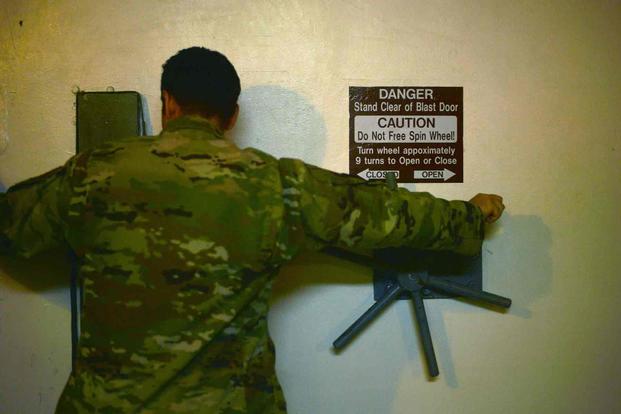This story, part of a series of investigative reporting projects by Military.com on service member and veteran health, was supported by the Pulitzer Center.
As a white truck barrels down a dirt road through the Great Plains, heading from F.E. Warren Air Force Base in Wyoming to a location just over the Nebraska border, the driver points a Military.com reporter to a chain-link fence just beyond a herd of black cows grazing the snow-covered fields.
Behind the cattle and the barbed-wire perimeter lies a nuclear missile, tucked under the earth and out of sight. To an untrained eye, these sites could easily go unnoticed and, likewise, the young enlisted airmen and early-career officers who take on the high-stress jobs to protect, maintain and, if called upon, launch those nuclear weapons, are also out of public view.
When many former missileers started to worry that they may have been exposed to cancer-causing toxins at missile alert facilities and launch control centers, they felt those concerns were being buried too. Military.com wanted to bring their voices to the surface.
Read Next: Here Are Soldiers' Top Choices for First Duty Stations
Over the course of several months, Military.com dove into the cancer concerns of America's missileers and the stressful jobs they take on to support the nation's nuclear triad -- the combination of air-, land- and sea-based nuclear weapons that can respond to a threat at a moment's notice.
The story caught Military.com's attention on Jan. 21, 2023, when screenshots of a presentation titled "The Malmstrom Initiative" began circulating online.
The presentation was created by Danny Sebeck, an active-duty Space Force officer and former missileer who was diagnosed with non-Hodgkin lymphoma. He began researching other cases of missileers diagnosed with cancer and discovered 36 diagnoses among missileers who had been stationed at Malmstrom Air Force Base in Montana. Ten of the airmen who had received cancer diagnoses, according to Sebeck's research, developed non-Hodgkin lymphoma. Two developed Hodgkin lymphoma, and 24 developed other forms of cancer.
Last year, Malmstrom and Minot Air Force Base in North Dakota both found levels of PCBs above the Environmental Protection Agency's threshold, though the Air Force did not disclose the specific concentration that tests revealed. F.E. Warren also detected the carcinogen but in much smaller traces, the service said.

Military.com began to dig into the claims and wondered whether the issue of potential cancer clusters among America's missileers had been raised before.
With guidance from the Reporters Committee for Freedom of the Press, a nonprofit organization that has been advising Military.com on the newsroom's Freedom of Information Act request efforts, we sought past studies and records that could have revealed earlier worries and indications. That search revealed documents showing that concerns over carcinogens at those facilities had been raised decades prior.
Military.com also received funding from the Pulitzer Center, which financially supported a reporting trip to F.E. Warren Air Force Base in Cheyenne, Wyoming, one of the nation's three intercontinental ballistic missile bases. On-base officials granted us interviews with top military officers and experts and also escorted us to a military alert facility and launch control center 60 feet underground to see for ourselves the environment where America's young service members carry out their mission.
But the biggest resource in Military.com's reporting was the current and former missileers themselves.
We reached out to the Association of Air Force Missileers, which helped connect Military.com with missileers who have health concerns. We received dozens of phone calls and emails and spoke with missileers ranging from all different duty stations and generations of service who made their concerns and worries known to us.
Shortly after "The Malmstrom Initiative" presentation, a group called the Torchlight Initiative was created by former missileers. This organization provided Military.com with dozens of Air Force documents detailing cancer and toxin concerns, as well as data from their own grassroots registry of maintainers, security forces and missileers who were diagnosed with cancer and feared it could have been connected to their service.
As of February, the Torchlight Initiative found that 87, or about 25%, of the 347 registered missile community cancer cases at that time in its registry were blood cancers such as lymphoma, leukemia and myeloma. By comparison, of cancer diagnoses in the U.S., 10% are blood cancers, according to a fact sheet from Yale Medicine, the Ivy League university's medical school.

The Torchlight Initiative also sent our contact information to its members, who called and emailed to voice their concerns about the past studies and how their service could be connected to their cancer or fears of getting sick in the future.
Several missileers and their family members invited Miltiary.com into their homes in Colorado and shared their health diagnoses, their constant fears, and their grief in losing loved ones to cancer. Ultimately, our newsroom couldn't have written this report without their trust and their willingness to share their stories with us.
For years, many missileers felt like their voices were unheard, but Military.com was grateful we had the chance to sit down and listen.













